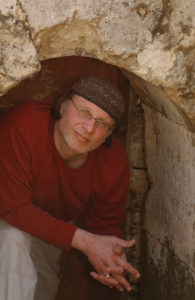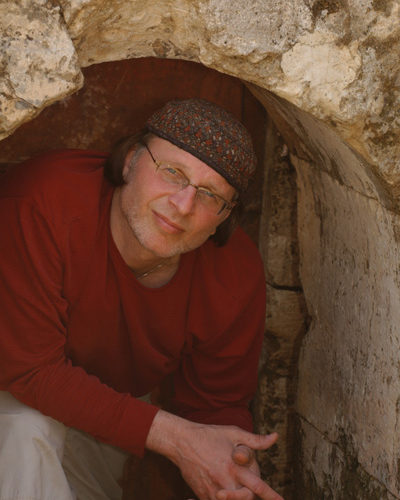One on One Interview with Simcha Jacobovici
By Charley J. Levine
 A prolific documentary filmmaker-journalist as well as adjunct professor of religious studies at Huntington University in Ontario, Israeli-born Canadian Simcha Jacobovici, 59, intrigues and challenges international audiences and academics. He has won three Emmys in Investigative Journalism and his documentary on Jesus will air soon on American television. His book, The Jesus Discovery: The Resurrection Tomb that Reveals the Birth of Christianity (Simon & Schuster), coauthored with James D. Tabor, was just published. Jacobovici and his family made aliya in 2009 and he travels between Israel and Canada.
A prolific documentary filmmaker-journalist as well as adjunct professor of religious studies at Huntington University in Ontario, Israeli-born Canadian Simcha Jacobovici, 59, intrigues and challenges international audiences and academics. He has won three Emmys in Investigative Journalism and his documentary on Jesus will air soon on American television. His book, The Jesus Discovery: The Resurrection Tomb that Reveals the Birth of Christianity (Simon & Schuster), coauthored with James D. Tabor, was just published. Jacobovici and his family made aliya in 2009 and he travels between Israel and Canada.
Q. Where do you think Jesus is buried?
A. In 2007, we made headlines with a film, The Lost Tomb of Jesus, and a book, The Jesus Family Tomb (HarperOne), that pinpointed the real tomb of Jesus of Nazareth and his family. It’s not the Church of the Holy Sepulchre—that was a temporary tomb…used immediately after the crucifixion. It’s a family tomb in Talpiot, Jerusalem; the bone boxes of 10 people were discovered. Six had names inscribed on them; one is called Jesus, son of Joseph. Next to him there is a Maria, the mother; Jose, a nickname associated in the Gospels with one of Jesus’ brothers; Mariamene, a Greek version of Mary, associated only with Mary Magdalene; and a Judah, son of Jesus.
Q. What is your new film about?
A. Much of the world scoffed that Jesus was a common name, that this was not Jesus of Nazareth. Flash-forward to 2012. Two hundred feet from the alleged Jesus family tomb…there is an unexcavated 2,000-year-old tomb. While the controversy raged, our team continued the investigation. We built a robotic arm and secured the cooperation of the Israel Antiquities Authority, the religious authorities, the apartment building management committee and the police to investigate this second tomb. We wanted to know if Tomb II would throw light on Tomb I. Audiences will be thrilled to see a history-altering discovery as it unfolds live on camera in this new film.
Q. Why have you focused so much on Jesus?
A. Were many Jews as influential as Jesus? Was this tomb found outside of Israel? Two thousand years of persecution has led us to regard the birth of Christianity as someone else’s story. But not only is this one of the most fascinating stories ever told, it happens to be…a thoroughly Jewish narrative. The irony is that we are afraid to address it. It’s as if we are still living in a ghetto next to the Vatican. I’m a journalist. If it’s a great story, I pursue it.
Q. As Jews worldwide recount the plagues that befell our ancestors long ago in Egypt on Passover, what has your research added to the retelling?
A. It’s funny you say that. I have just been commissioned by Palphot [publishers] in Israel to produce a Haggada based on my documentary The Exodus Decoded. It’s going to…look at the archaeology behind the liturgy.
Q. Which specific dots did that film connect?
A. It showed…archaeological evidence for the Exodus. For the Orthodox, there was some reticence in certain quarters to look for scientific explanations behind the miracles. But that is exactly what the Rambam [Maimonides] does! For him, God is not a trickster suspending nature, He is master of the universe who has made nature part of his unfolding plan. Once you understand the historical context, it forces you to reread the Torah and understand the story in a new way. For example, the seventh plague is an unusual type of hail: ice on the outside, fire on the inside. Volcanologists call this “accretionary lapilli,” and it arrived in Egypt as a result of one of the worst volcanic eruptions in history—the eruption of the volcano Thera/Santorini, off the coast of Greece. I actually have a piece of pumice from Egypt retrieved by archaeologists at the archaeological level of the biblical Exodus. When we sit down at the Seder table, we literally have an example of one of the plagues at our Passover meal. The biblical plague of darkness was also part of the ash cloud that enveloped Egypt as a result of Santorini.
Q. Your films have been shown on the History Channel and Discovery Channel. In a National Geographic Channel documentary, you claim you found the lost city of Atlantis. How do you explain your find?
A. Many people dismiss Atlantis as a myth. I believe that behind every myth is real history or the story would not have endured. I became convinced that what Plato calls Atlantis is what historians call Tartessos and what the Bible calls Tarshish. These cities were all in southern Spain, were all wealthy and were all involved in Canaanite-type rituals. Moreover, all three disappeared from the historical record. Once we realized they were all the same city called by different names, the rest was easy.
Q. When did your sleuthing turn to hard science?
A. I was working with Professor Richard Freund of Hartford University. Satellite photography, ground-penetrating radar and archaeology all suggest southern Spain—specifically, the area of Doña Ana—is the site of Atlantis/Tarshish. This is also the destination for the prophet Jonah’s voyage—he was sailing for Atlantis! The area was colonized by ancient Israelites and coastal Canaanites. The Israelites seemed to have come from the tribe of Gad. It’s not accidental…that the word Gad, or Guad in Spanish, appears all over southern Spain—Guadalquivir, Guadalupe, Guadiana. Natives of the Spanish city Cadiz still call themselves Gaditanos. Every Monday in synagogue we read Psalm 48, which seems to celebrate that Jerusalem was not destroyed when Tarshish was wrecked. It recounts that the earth shook like “a woman giving birth.” It talks about the ships of Tarshish being destroyed. People think of Atlantis as a continent, but the only source for the story is Plato. He talks about it as a fantastic city. I realized this psalm was celebrating Jerusalem’s survival the day Atlantis went down. You can say that I found Atlantis in synagogue.
Q. Your fans are loyal but critics charge you with sensationalism and tenuous conclusions. Why?
A. Generally, investigative journalists stick to politics and contemporary social issues rather than history and archaeology. I bring the skills of investigative journalism into religion and history. Scholars do not take to outsiders on their turf, and I’m as outside as you can get. As a filmmaker, I am not subject to university pressures. I don’t look for headlines. I spend years investigating a topic.
Q. What transformed you from a Canadian Jewish student activist to a committed Zionist and suburban soccer dad living in Israel?
A. I don’t know that I have been transformed. I was born in Israel, grew up in Canada and came back for my [Israel Defense Forces] service. I continue to commute to my office in Toronto. It’s true that I did not grow up observant and I’m Orthodox today. I’m totally committed to Judaism and Zionism. I wanted my four daughters and son to grow up in the only Jewish state we have. The family loves being here, and although I still bring organic maple syrup back from Canada, everyone feels at home. As for soccer, I am vicariously living out my fantasies through my 10-year-old son, who was asked to play for a Brazilian youth team when he was only 8.
Q. What subjects will you explore in the years ahead?
A. Even though I’ve made films about the Ebola virus and sex trafficking in India, I am obsessed with Jewish history—often the secret history of Jews in comic books, Jews in sports, Jewish pirates and so on. I think the unique experience of the Jews has been an engine of humanity’s history. By exploring one aspect of the equation, you explore it all. I’m also fascinated with the Second Temple period. Not only did it lead to the birth of Christianity, but it led to the destruction of ancient Judea and a 2,000-year-old diaspora that only recently came to an end. What amazes me is that we, as a people, have literally picked up where we left off—same arguments, same divisions: religious versus secular, nationalist versus assimilationist, ultra-Orthodox versus various shades of Reform. There’s nothing wrong with diversity, but if you look at the Second Temple period, you see that the diversities often turned into a civil war that ultimately brought us down. I think by telling the true story of what happened then, we can influence for the better the choices we make today.

